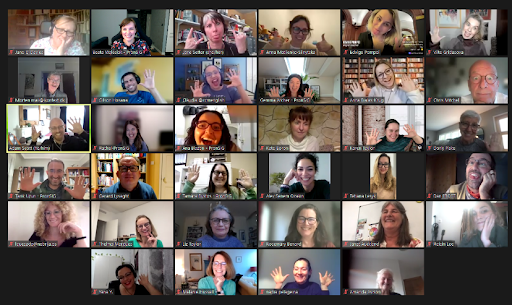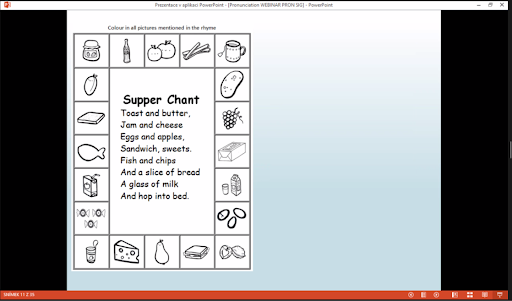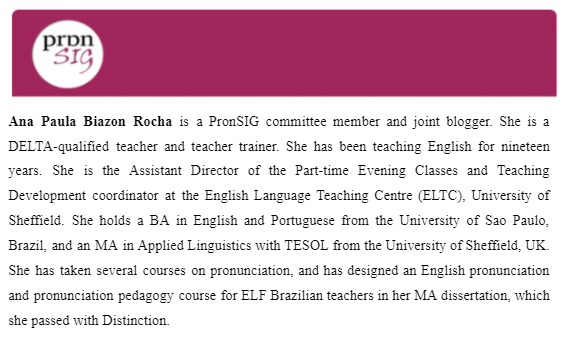by Ana Paula Biazon Rocha
Participants from all over the world joined PronSIG’s online conference, ‘Musical pronunciation: teaching the perception and production of English prosody’, on 14 Oct 2023 (Sat). It was an excellent opportunity to share and learn more about the pivotal role of prosody in English pronunciation, and the special relationship between language and music (if you are unsure about what the term ‘prosody’ entails, check this blog post). Thus, in this post, we will review and focus on three main takeaways from such a ‘pron-musical’ event.

Image 1: How fun was our conference, huh?!
1. ‘Emphasising suprasegmentals (or prosody) when it comes to pronunciation teaching/learning’ (participant’s feedback)
Pronunciation teaching goes beyond the difference between the so-called short ‘i’ sound and long ‘i’ sound as in ship /ʃɪp/ and sheep /ʃiːp/, respectively. I’ve been there, done that, bought the T-shirt, and possibly so have you, so let us all stand by each other, no shame! 🙂 As a recurrent discussion in this blog, a great number of teachers overfocus on vowel and consonant sounds when teaching pronunciation because of a lack of confidence, skills, and knowledge in teaching suprasegmental/prosodic features. A lot of course books also tend to take this route, and it might seem like a wise choice, because it is better to teach some pronunciation than nothing, right?…Well, our conference showed us that it is time to change! If we want to support learners’ comprehension and communication skills, prosody is the real deal. The music of English is composed of stress, rhythm, thought groups or chunking, intonation, and connected speech, and they are really what the majority of learners (and teachers?) struggle with. Adding more of these features to your pronunciation teaching is the first step!
2. ‘Music is us. We are born with this musical aptitude’ (Giedrė Balčytytė)
In the opening plenary, Giedrė Balčytytė reminded us that humans are musical beings: a) when mothers speak/sing to their babies, words are more musical, and later on, they become speech; b) the brain mechanisms responsible for language and music interact and are connected, and c) we have already come across the ‘song stuck in my head’ phenomenon, a catchy song that you cannot seem to forget. Similarly, both language and music have hierarchical structures, in other words, they have their own grammar and syntax.

Image 2: Slide from Balčytytė’s opening plenary
Therefore, the more teachers make use of ‘musical’ strategies to teach pronunciation, such as body movements (clapping or tapping), poetry, nursery rhymes, chants, songs, and music exercises, the better for students. Chants, for instance, are a common resource to teach pronunciation to young learners, as illustrated by Sylvie Dolakova’s session, “Rhythm and stress in primary classes”.

Image 3: Slide from Dolakova’s session (3B)
You can also find lots of chants, rhymes, songs, and poems to work with learners in Mark Hancock’s highly acclaimed PronPack (2017).
3. ‘Intonation is a feature of speech in English’ (Jane Setter)
In the closing plenary, Jane Setter, one of the most recognised experts in English phonetics, and former PronSIG committee member, wowed us with an information-packed session on English intonation and how to teach it. Initially, Setter pointed out that intonation is one of the first aspects acquired by children (watch this video to see a clear illustration of this).
Intonation refers to changes in pitch (how high or low a sound is), which are based on the speaker’s control, are perceptible, and show contrast (from one pitch pattern to another). Thus, intonation in English is composed of:
a. Tonality: how the speech is divided into tone units, also known as ‘thought groups’ or ‘chunking’.
For example:
| PronSIG’s conference was great | (the bar | indicates a tone unit or a chunk).
b. Tonicity: the placement of the tonic syllable, also known as ‘focus placement’ or ‘sentence focus’.
For example:
- | PronSIG’s conference was great | (if I want to emphasise my opinion about the conference).
- | PronSIG’s conference was great | (if I want to say that the conference was great as compared to a webinar, or blog, etc.).
- | PronSIG’s conference was great | (if I want to emphasise this IATEFL SIG – special interest group – instead of others).
c. Tone: pitch movement associated with the nucleus, for example, fall↘ and rise↗.
For example:
- PronSIG’s conference was great.↘ [fall] (a common tone pattern in statements in English)
- PronSIG’s conference was great.↗ [rise] (maybe I’m being sarcastic and I really didn’t like the conference, or maybe I’m not fully convinced that the conference was great, and I’m questioning it).
You can listen to the three aspects, tonality, tonicity and tone, here.
If, at this point, you are already shaking and crying, thinking: ‘How am I going to teach these things? I have no clue…’, take a deep breath and calm down! Setter reinforced that when it comes to teaching intonation, we should start from the beginning: Can learners recognise any differences when they hear, ‘PronSIG’s conference was great.’↘ [fall] and ‘PronSIG’s conference was great.’↗[rise]? If they can perceive this, we can introduce the idea of a falling tone and a rising tone. If they cannot, take a step back and re-focus: perhaps they are not ready yet, linguistically-speaking, to deal with intonation. They might need more practice on stress and rhythm in English, as opposed to their L1, before grasping the idea of changes in pitch patterns. It is OK, you can come back to that later. Remember: learning is a process, there are steps to follow. An anxious teacher can unconsciously influence an already anxious student.

Image 4: Slide from Setter’s closing plenary
If you have already had the chance to read our blog post, Top 6 tips on teaching intonation from Lucy Pickering’s sessions for IATEFL PronSIG (Nov 2021), you might notice that Pickering referred to very similar ideas to Setter’s but using different terms, such as ‘prominence’, ‘pitch’, and ‘pause’ rather than ‘tonality’, ‘tonicity’ and ‘tone’. Why?, you might ask. The reason is that they are both from different English intonation schools: Pickering is based in the US, and Setter, in the UK. In other words, they are saying the same things but using different terminology. In addition, the American school is highly influenced by Discourse Intonation (Pickering, 2018), which focuses on ‘clear communication of information in conversational contexts and indication of social convergence and divergence’ (Setter & Makino, 2021, p. 544), whereas the British school ‘focuses mainly on attitudinal and grammatical meaning’ when approaching intonation (Setter & Makino, 2021, p. 542).
There is a lot to process, so do take your time! If you registered for our conference, you can already (re)watch the sessions, check your inbox for details of how to access these. If you didn’t, you can access the full conference recordings by giving us a donation (recommended donation is £5),click here for more information.
For more tips, ideas and discussions on pronunciation teaching, please check our previous blog posts, and spread the word. Don’t forget to follow PronSIG on social media and leave your comments below. If you are a PronSIG member, don’t forget to join our Book Club event on 11 Nov 2023 (Sat). If you are not, no time like the present! Join PronSIG now.
References
Pickering, L. (2018). Discourse Intonation: A discourse-pragmatic approach to teaching the pronunciation of English. University of Michigan Press.
Setter, J. & Makino, T. (2021) Pronunciation teaching. In Knight, R.-A., & Setter, J. (Eds.) The Cambridge Handbook of Phonetics. Cambridge University Press. p. 527-550.


